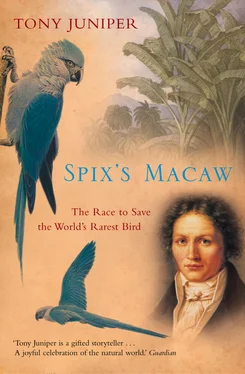Astonishingly, Spix’s Macaw effectively disappeared from the eyes of naturalists and travellers, and was not observed in the wild for eighty-four years after Spix had first encountered one. The fact that Spix’s Macaw was a rare bird was not lost on the early cataloguers and naturalists. Indeed, no European recorded one alive in the wild again until the start of the twentieth century when Othmar Reiser saw Spix’s Macaws during an expedition of the Austrian Academy of Sciences to north-eastern Brazil in June 1903.
He wrote, ‘As I knew that Spix had discovered this rare and beautiful parrot in the area of the river São Francisco near Juàzeiro, I made sure to keep an eye out for it in the area described. Unfortunately without success. Any enquiries made to the local people were also negative.’ Finally, at the lake at Parnaguá in the state of Piauí, more than 400 kilometres to the west of Juàzeiro, Reiser and his companions were rewarded with two sightings of the elusive blue bird. They reported one sighting of three birds and another of a pair. ‘They arrive apparently from a long distance and the thirsty birds at first perch, calling, on the tops of the trees on the beach to survey the surrounding area as a precaution. After flapping their wings for a few times they fly down to the ground with ease and drink slowly and long from pools or the water at the bank.’ 2
Reiser tried to approach but found the birds nervous and not tolerant of people. His attempts to shoot the macaws in order to obtain a specimen failed. ‘So it was that the parrot species most desired by us was the only one to be observed, but not collected’, he wrote. The only other encounter with Spix’s Macaw noted during this expedition was a captive bird shown to the party in the town of Remanso. Reiser tried to buy it, but lamented that it was not for sale.
But other Spix’s Macaws were for sale. Despite the lack of scientific observations by naturalists working in the field, the blue parrots were certainly leaving Brazil for a life in captivity overseas.
In 1878, the Zoological Society of London at Regent’s Park had obtained a live bird for its collection from Paris. It died and so the zoo set out to get hold of a replacement. In November 1894, a second bird was procured for the Society by Walter Rothschild: that one lasted until 1900. A third was held at the London Zoo from June 1901 but expired after just a year. These individuals were among a steady trickle that by the late nineteenth century were being exported to meet a growing demand for live rare parrots. In common with other rare species, when these birds died they were often included in museum collections. Following the demise of the first Zoological Society specimen, its skin was preserved and placed in the collection held by the British (now Natural History) Museum at Tring in Hertfordshire. The second London bird’s skin is now kept in the American Museum of Natural History in New York. And it wasn’t only the large zoological institutions like London that were interested in owning them. In late Victorian England, as in other parts of the world, aviculture was growing in popularity, and private bird collectors certainly knew of the Spix’s Macaw as a rare and desirable addition to a parrot fancier’s aviaries.
In the December 1897 issue of Avicultural Magazine , a journal for serious bird keepers, the Honourable and Reverend F. G. Dutton from Bibury in Gloucestershire wrote, ‘Have any of our members kept a Spix? I have seen only two – one that our zoo acquired some years ago from the Jardin d’Acclimatation [in Paris], and one bought by Mr Rothschild … They were both ill tempered: but as the first had a broken wing, it had probably been caught old. I was greatly tempted by the offer of one from Mr Cross the other day, but there are so many calls on a parson’s purse, that he cannot always treat himself to expensive parrots. I ought to have been keeper at the parrot-house in the zoo.’ Although he does not mention a price, it is clear that even in the late nineteenth century Spix’s Macaws were the preserve of the more discerning and wealthier bird collectors.
After Dutton had published his request for details on any Spix’s Macaws kept in Britain at that time, a Mr Henry Fulljames of Elmbourne Road in Balham, London, came forward. The Reverend soon paid Fulljames a visit at his house to view his parrot collection. Dutton wrote, ‘Lastly, the most interesting bird was the Spix’s Macaw … It was very tame and gentle, but not, as regards plumage, in the best of condition. I never can see a bird in rough plumage without longing to get it right. And so it has been arranged between Mr Fulljames and myself that I should have the Spix at Bibury, and try what a little outdoor life might do for it.’ Although Dutton had hatched an apparently foolproof plan to have a Spix’s Macaw for free, at least temporarily, Henry Fulljames’s housekeeper put an end to the scheme. She was very reluctant to lose sight of the Spix’s and the bird stayed where it was.
The Reverend persevered, however, and by September 1900 he had acquired a Spix’s Macaw of his own. ‘My Spix, which is really more a conure than a macaw, will not look at sop of any sort,’ he wrote, ‘except sponge cake given from one’s fingers, only drinks plain water and lives mainly on sunflower seed. It has hemp, millet, canary and peanuts but I do not think it eats much of any of them. It barks the branches of the tree where it is loose, and may eat the bark. It would very likely be all the better if it would eat bread and milk, as it might then produce some flight feathers, which it never yet has had.’ He later wrote that his Spix’s Macaw, which lived in his study, was learning to talk.
The Reverend Dutton was not the only one to wonder if Spix’s Macaw might not be closer to the conures than the other macaws. Conures are slender parrots with long tails. They are confined to the Americas and are mainly included in two genera: Aratinga and Pyrrhura . Several writers repeated Dutton’s conjecture, but given the many macaw-like characteristics of Cyanopsitta it is safer to assume that it is a macaw.
By the early twentieth century, Spix’s Macaws were well known among bird keepers, at least from books. In Butler’s 1909 Foreign Birds for Cage and Aviary , the author refers to the earlier published claims that Spix’s Macaws are bad-tempered birds. ‘As all bird keepers know well,’ Butler wrote, ‘it is impossible to be certain of the character of any species from the study of one or two examples only. Even in the case of birds which are generally ill tempered and malicious, amiable individuals may occasionally be met with. Moreover circumstances may alter cases, and a Parrot chained by the leg to a stand may be excused for being more morose than one in a roomy cage.’ Butler, in common with previous commentators, remarked that Spix’s Macaws were extremely rare.
Another famous aviculturist in the early part of the twentieth century was the Marquis of Tavistock. In his book on Parrots and Parrot-like Birds in Aviculture published in the 1920s, he remarked that, ‘This rather attractive little blue macaw was formerly extremely rare, but a few have been brought over during recent years. It is not noisy, is easily tamed and sometimes makes a fair talker. There seems to be little information as to its ability to stand cold or as to its behaviour in mixed company, but it is probably neither delicate nor spiteful … In the living bird the feathers of the head and neck stand out in a curious fashion, giving a peculiar and distinctive appearance.’
While birds occasionally turned up in collections, attempts to find Spix’s Macaws in the wild were repeatedly frustrated. In 1927, Ernst Kaempfer had been in the field with his wife collecting birds in eastern Brazil for two years. Although the Kaempfers had managed to ship some 3,500 bird specimens back to the American Museum of Natural History in New York City, the Spix’s Macaw still eluded them.
Читать дальше












